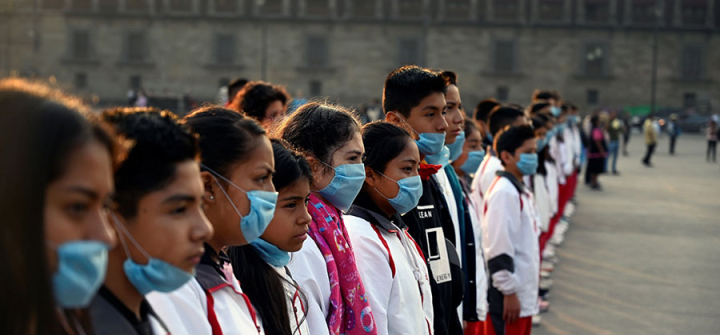Start Local to Stop Air Pollution
Air pollution contributes to 5 million deaths globally each year and causes stunted growth, cognitive deficits, heart and lung disease and other problems.
But some cities and countries have made significant progress in reducing air pollution. The key is to know the local sources and target them, says Daniel Kass, senior vice president for Environmental Health at Vital Strategies,
A #WHA72 side event on Tuesday, “Every Breath Can Do Damage: The Urgency of Air Pollution Action,” will convene experts from ministries of health and civil society to discuss the impact of air pollution and proven, cost-effective interventions. The event, which will be livestreamed at 12:30 p.m. CEST (6:30 a.m. EST) Tuesday, is sponsored by Vital Strategies and the NCD Alliance.
In this Q&A, Kass shares insights on recent trends and successful policies—why local solutions are essential.
What do the latest data say about the human costs of air pollution worldwide?
Air pollution contributes to around 5 million deaths each year—nearly 1 in every 10 deaths, lowering [global] life expectancy by 1 year and 8 months. It is the 5th leading risk factor for mortality worldwide, ahead of other modifiable risk factors such as malnutrition and physical inactivity. The economic costs to the global economy—$255 billion in lost labor income and over $5 trillion in welfare losses—are enormous. Of course, in some countries, air pollution is even more serious [and is] even the third and fourth leading risk factor for mortality.
How are things trending? Is air pollution getting better or worse?
Air pollution levels and trends vary greatly across countries and regions. On average, levels have decreased over the past 15 years throughout much of Europe and the Americas through … clean air programs and policies. They have also decreased slightly in some parts of Asia, though South Asian countries like Mongolia, Nepal, India and Bangladesh have some of the worst air quality globally. Levels are increasing throughout much of Africa, and without significant changes in emissions standards, [they] will rise in much of Asia as population and wealth grows.
Air pollution is increasingly being linked to noncommunicable diseases and the response to them. Connect the dots for us. What NCDs are affected by air pollution and would they decrease appreciably if we solve the pollution problem?
Every year, NCDs—mainly heart and lung disease, cancer, and diabetes—kill 41 million people globally. Air pollution is a leading risk factor for NCDs, especially in low- and middle-income countries. For example, it accounts for 41% of all deaths from chronic obstructive pulmonary disease. Health impacts begin before birth, with air pollution contributing to low birthweight, stunting and other adverse pregnancy outcomes that can increase the risk of NCDs throughout the life course, and even to lifetime cognitive deficits and behavioral disorders.
We’ve all seen photos of smog in Beijing and other global cities. Where are the biggest problems with air pollution?
"Problem" is a multifaceted concept, and the problem of air pollution certainly involves health impacts. The problem of air pollution also relates to the global reality that air pollution represents a classic economic market failure: Savings in emissions control and savings in dirty fuels result in even greater transferred costs to the health sector, economic development and related social costs—usually borne disproportionately by governments and lower income families.
The problem of air pollution also refers to its sources, which vary greatly. In some areas, especially urban areas, vehicle exhaust or industrial emissions might be the biggest local sources. In others, household solid fuel use, urban and agricultural waste burning or forest fires might be the leading sources, and often contribute substantially to air quality in surrounding areas. That is why it is important to ensure that each locality identify the leading sources of pollution when designing and implementing effective policies and programs to address the issue.
What cities or countries are the best models for solving the air pollution problem? What works best?
There is no “one size fits all” solution; the most effective strategies involve addressing leading sources of pollution. For some, regulatory action like fuel standards, action at the state or national levels is most effective. Here in New York City, transitioning to cleaner heating fuels resulted in substantial air quality and health benefits.
In Hong Kong, city officials mitigated air pollution by regulating emissions from marine vessels. Elsewhere, policymakers are addressing agricultural burning, household energy, traffic pollution and industrial sources. In each case, however, these areas correctly identified key sources of air pollution, addressed them via policy and enforcement solutions, and engaged the public to engender support for their actions.
Ed. Note: This interview has been edited for clarity and length.
More news from #WHA72 here.
Join the tens of thousands of subscribers who rely on Global Health NOW summaries and exclusive articles for the latest public health news. Sign up for our free weekday enewsletter, and please share the link with friends and colleagues: Subscribe to GHN
A group of students wear face masks to protect from air pollution during a ceremony at Zocalo Square in Mexico City on May 17, 2019. Alfredo Estrella/AFP/Getty Images




